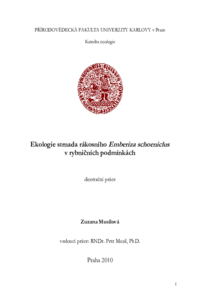Ekologie strnada rákosního Emberiza schoeniclus v rybničních podmínkách
Ecology of the Reed Bunting Emberiza schoeniclus in fishpond habitats
dizertační práce (OBHÁJENO)

Důvod omezené dostupnosti:
Přílohy práce nebo její části jsou nepřístupné v souladu s čl. 18a odst. 7 Studijního a zkušebního řádu Univerzity Karlovy v Praze ve spojení s čl. 9 opatření rektora č. 6/2010.
Zobrazit/
Trvalý odkaz
http://hdl.handle.net/20.500.11956/34893Identifikátory
SIS: 84848
Kolekce
- Kvalifikační práce [19614]
Autor
Vedoucí práce
Oponent práce
Procházka, Petr
Krištín, Anton
Fakulta / součást
Přírodovědecká fakulta
Obor
Zoologie
Katedra / ústav / klinika
Katedra zoologie
Datum obhajoby
17. 9. 2010
Nakladatel
Univerzita Karlova, Přírodovědecká fakultaJazyk
Čeština
Známka
Prospěl/a
5 ÚVOD a SHRNUTÍ "It would appear that, in response to a stable and predictable resource, many species have evolved a strategy of returning to the same network of areas throughout their life cycle...When wetland habitat is predictable, this is a good strategy, but increasingly, human disruption to annual cycles makes this a strategy that is less likely to ensure survival and successful reproduction." Tony Fox in Kear 2005: Duck, Geese and Swans, p 134 Studium ptačí "life-history" počínaje variabilitou ve velikosti a počtu vajec, přes dobu inkubace, počet snůšek za rok, až po přežívání mláďat a dospělců patří mezi již tradičně zkoumané odvětví ornitologie (Lack 1968, Owen & Black 1990, Newton 1998, Kear 2005, Benett & Owens 2005). Takřka ve všech stadiích svého životního cyklu jsou ptáci ohrožováni na životě, ať již z důvodů nedostatku potravy, predace, nepříznivého počasí, nemocí nebo lidskými zásahy (Benett & Owens 2005). V rámci ptačí říše existuje vysoká variabilita, jak se s těmito omezeními vyrovnat. Pomocí přírodní selekce dochází k optimalizaci investic do růstu, přežívání a reprodukce (např. Lack 1954, Lack 1968, Charnov & Krebs 1974). Tyto tři okruhy spolu velice úzce souvisí. Růst je náročný a snižuje energetické zásoby, které by mohly být investovány do reprodukce. Obdobně reprodukce omezuje...
10 SUMMARY Musilová, Z. & Musil, P. Nest site selection in the Reed Bunting Emberiza schoeniclus in fishpond habitats. submitted Nest site selection was analysed using variation in timing of breeding, nesting success and age of females in the Reed Bunting in fishpond habitats in mosaic Central European landscape. An example of habitat generalist using variable types of littoral vegetation is the Reed Bunting Emberiza schoeniclus, which occupies a wide scale of wetlands habitats (Blümel 1989, Cramp & Perrins 1994, Glutz von Blotzheim & Bauer 1997, Báldi & Kisbenedek 1999). Nevertheless, habitats generalists are supposed to be capable of not only occupying a wider range of habitats, but also exploring a wider range of resources (Brown 1984) including nest sites. We predicted that individuals with higher fitness are able to occupy optimal nest sites (Benett & Owens 2005). Survival and probability of recruitment are usually higher for early-hatched fledglings than for those hatched later (Lack 1968, Perrins 1970, Benett & Owens 2005). Reproductive success of older birds is generally higher than of the young ones (Curio 1983, Geslin et al. 2004). We can identify individual fitness using the following parameters: timing of breeding, nesting success and age of individuals. We evaluate habitat preference and...
